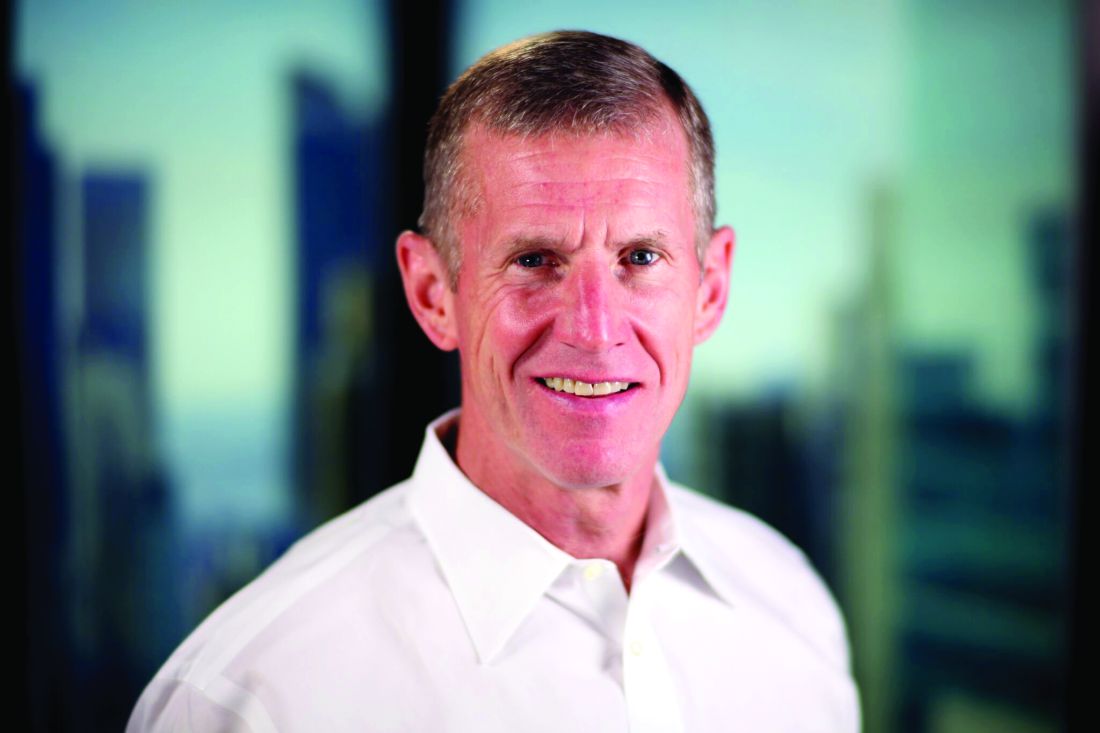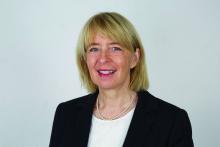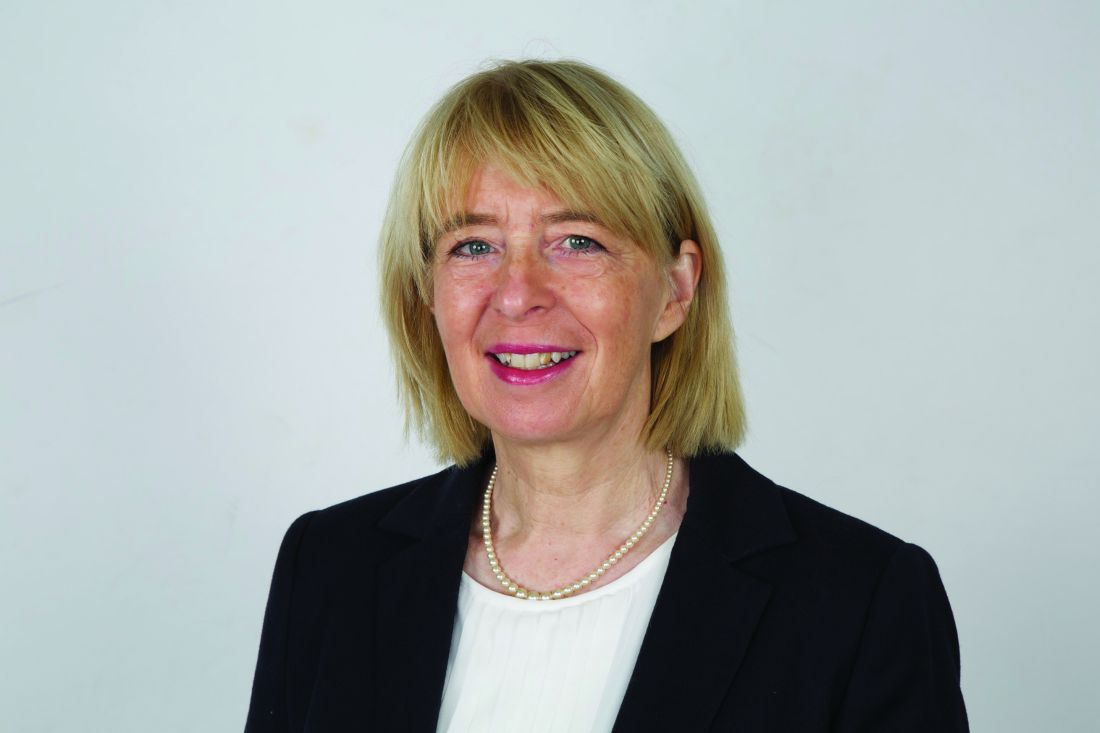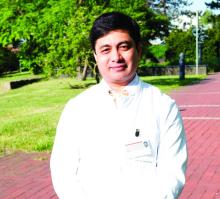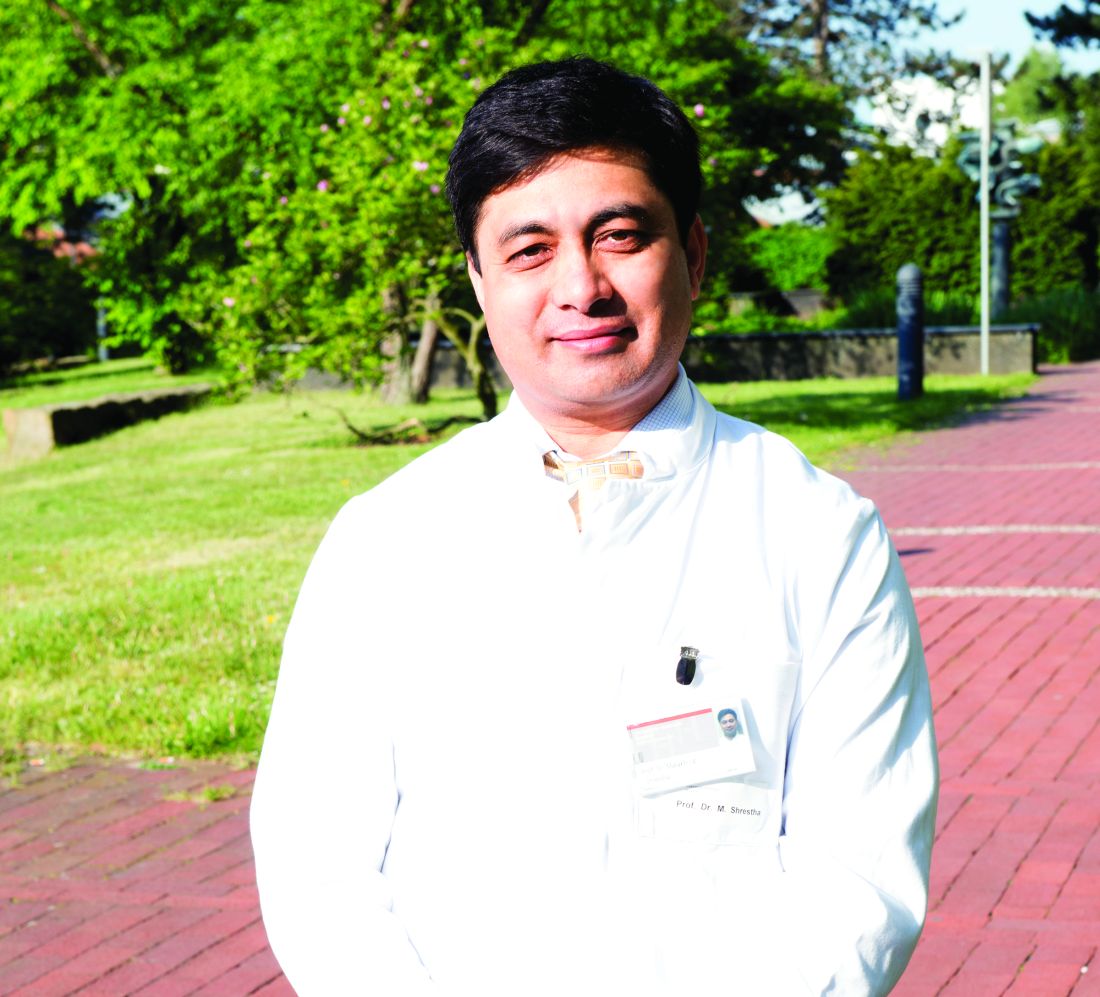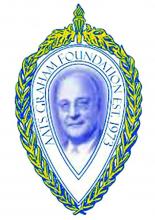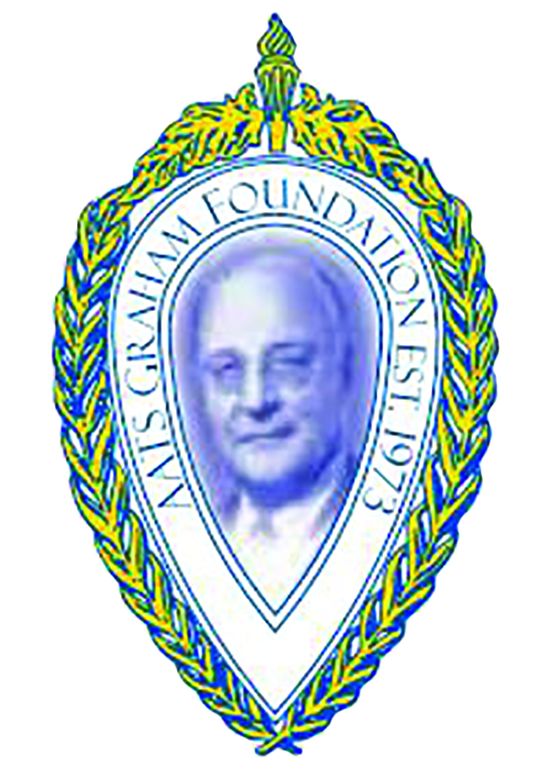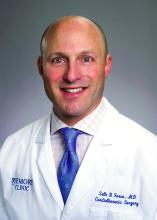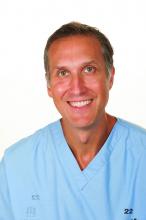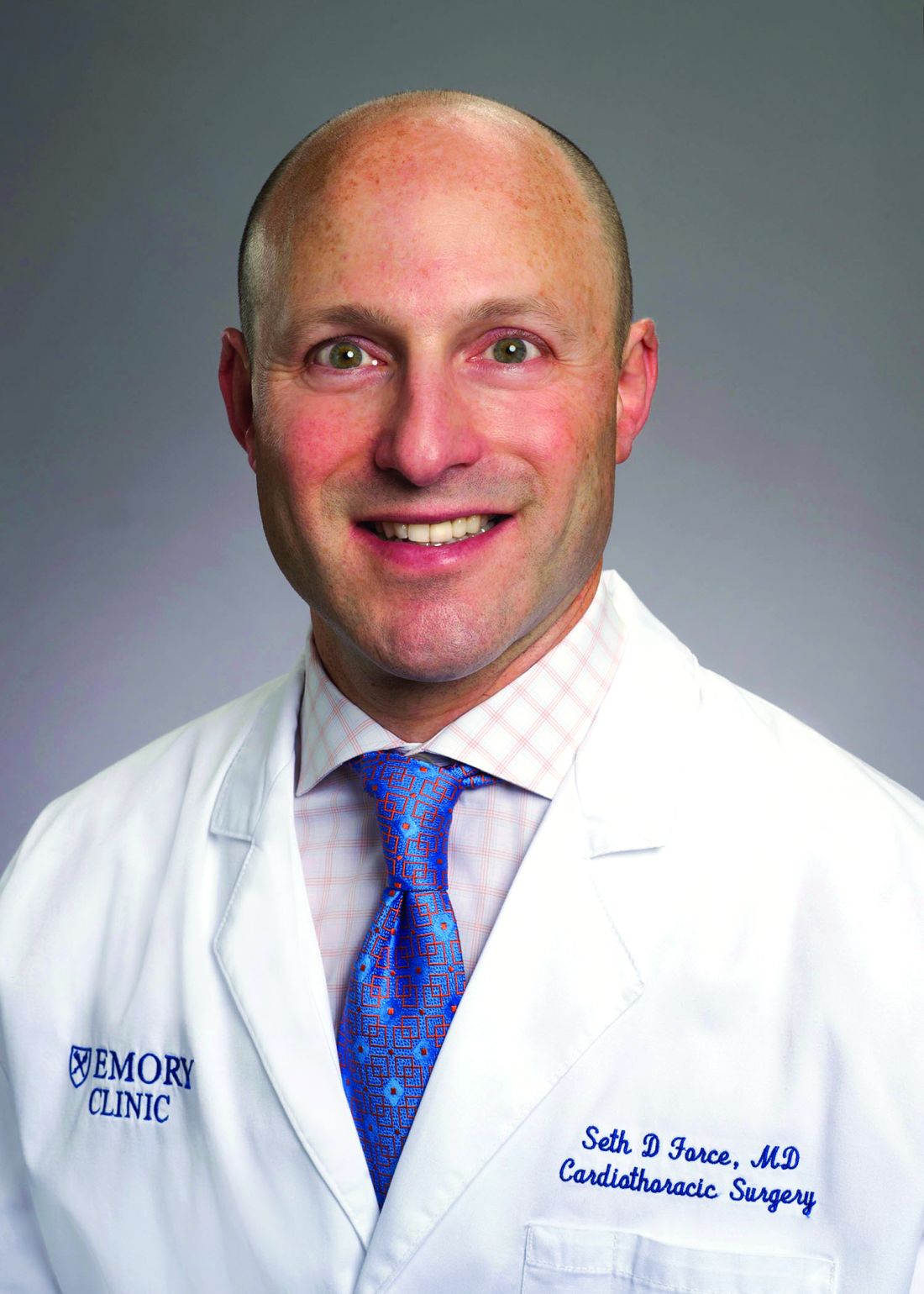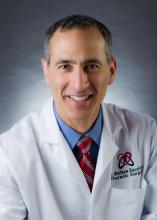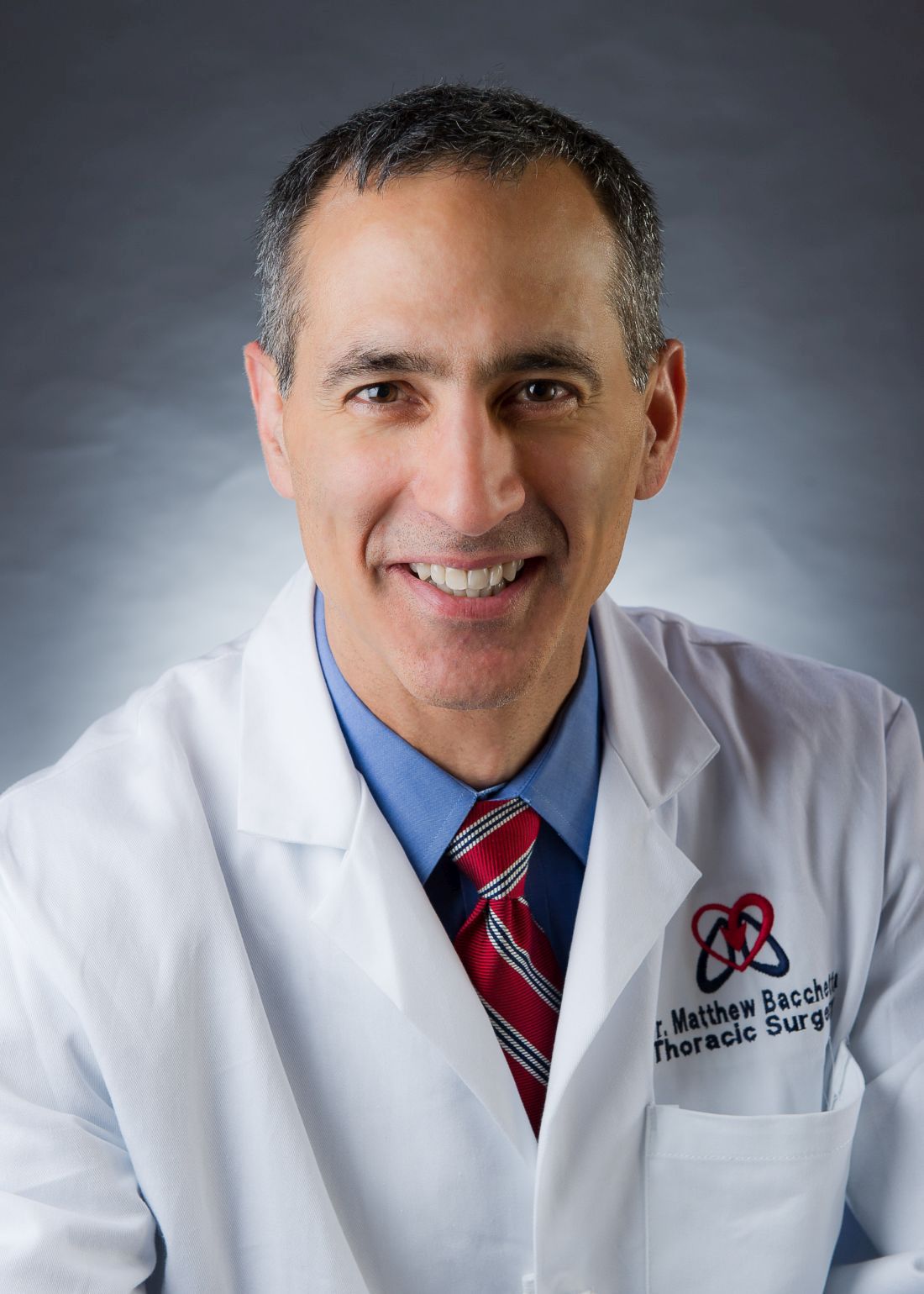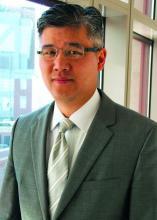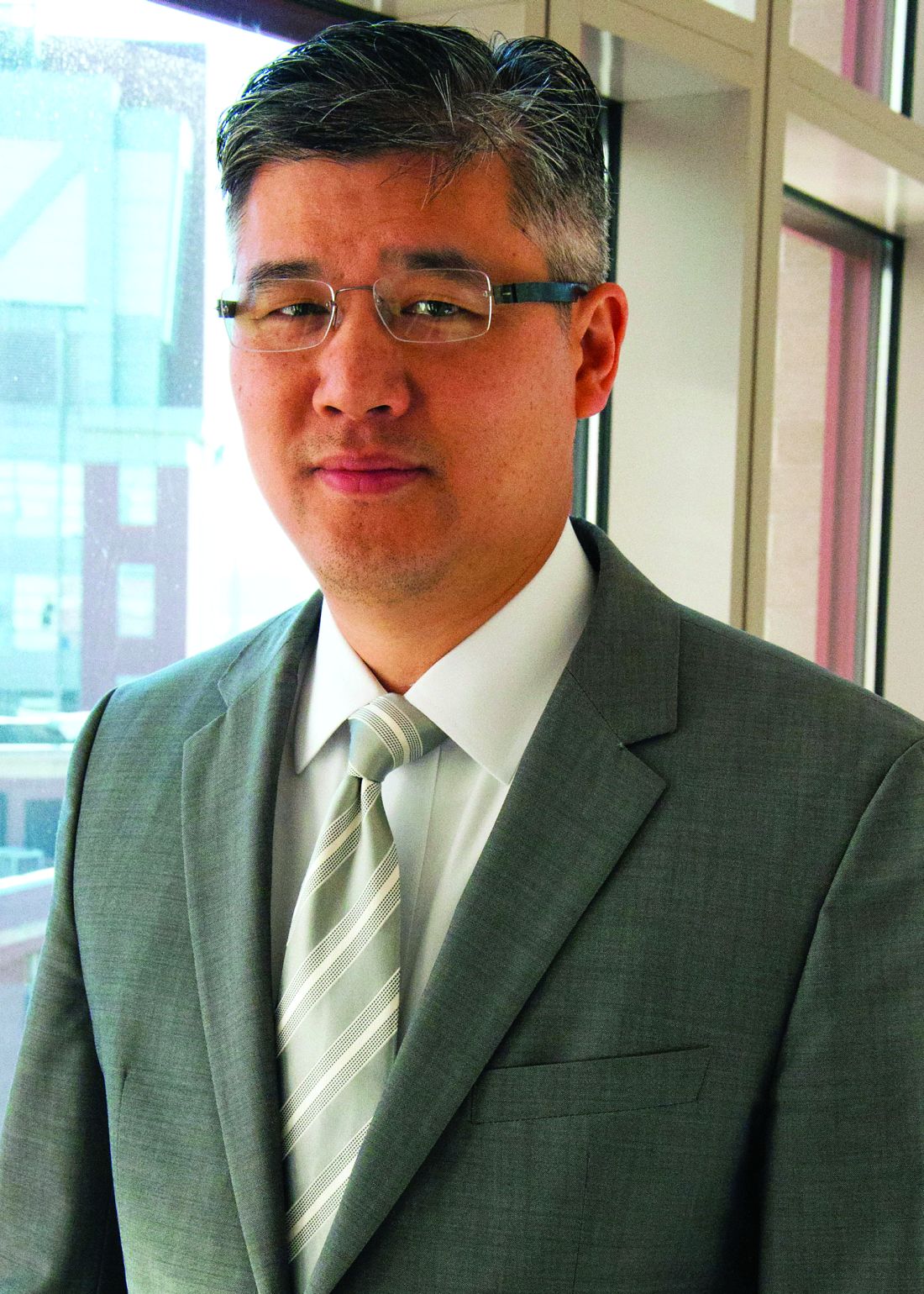User login
The Official Newspaper of the American Association for Thoracic Surgery
Can high hematocrit predict early shunt thrombosis?
Shunt occlusion has been a well-documented cause of shunt failure in newborns who have had systemic to pulmonary shunt placement, and little has been known about why shunts occlude. However, researchers have reported in a small retrospective study that higher postoperative hematocrit levels immediately after surgery may be predictors of shunt occlusion.
Reporting in the April 2017 issue of The Journal of Thoracic and Cardiovascular Surgery, Brett R. Anderson, MD, of New York-Presbyterian/Morgan Stanley Children’s Hospital, Columbia University Medical Center in New York, and coauthors, found that every 5-point increase in postoperative hematocrit more than doubled an infant’s odds of having early shunt occlusion (J Thorac Cardiovasc Surg. 2017;153:947-55).
“Beginning in the latter half of 2014, we noticed an increase in the incidence of early shunt occlusions in our neonatal cardiac intensive care unit,” Dr. Anderson and coauthors said. So they conducted a retrospective chart review of 80 infants who had undergone systemic to pulmonary shunt placement from January 2010 to July 2015, hypothesizing that increased hematocrit in the early postoperative period might have caused early shunt occlusion. They investigated the association between the first postoperative hematocrit and early shunt occlusion and in-hospital mortality in these patients.
Five patients (6.3%) experienced early shunt occlusion – that is, within 24 hours of placement (actually, within 10 hours of placement). Overall, 12 infants (15%) experienced shunt occlusion. The physicians at New York-Presbyterian do not administer anticoagulation in these patients during the first 12 hours after shunt placement.
The median initial postoperative hematocrit was 41.7%, with a range of 31.7%-55.8%. The survival analysis the researchers performed found that for every 5 additional percentage points, the hazard ratio for early shunt occlusion was 2.7 (P = .007) and 1.74 for any shunt occlusion (P less than .001). Incidentally, four cases of early shunt occlusion occurred in the later study period after 2014, during which the average first postoperative hematocrit was significantly higher than in the pre-2014 study period, 45.3% vs. 41.5% (P = .21), and the odds of early shunt occlusion were 16 times higher (P less than .001). Dr. Anderson and coauthors said the possible explanation for this variation was a switch to a new point-of-care analyzer in 2013.
With regard to mortality, six infants overall (7.4%) died before discharge, and four (5%) within 30 days of shunt placement. No infants with early shunt occlusion died, although two with late shunt occlusion died. Increased inotrope score and first postoperative arterial oxygen tension were the only factors associated with increased mortality. “No significant association was identified between hematocrit and 30-day mortality,” Dr. Anderson and coauthors said.
In the first 24 hours after surgery, 11 infants (13.8%) received packed red blood cell (PRBC) transfusions, seven (8.8%) received platelets, and four (5%) received fresh frozen plasma/cryoprecipitate. Higher postoperative PRBC transfusion volumes were associated with increased odds of mortality (P = .001), but none of these factors were significantly associated with early shunt occlusion.
Dr. Anderson and coauthors acknowledged that shunt occlusion is a “vexing problem” in infants with cyanotic heart disease. While other researchers studied postoperative hematocrit levels and possible associations with outcomes, including shunt occlusion and mortality, the New York-Presbyterian investigators said this is the first study of the first postoperative hematocrit.
Dr. Anderson and coauthors said their findings raise the question about the ideal perioperative prophylactic antithrombotic therapy in these patients. These researchers initiate aspirin therapy 12 hours after surgery if hemostasis is established.
As a result of this study, Dr. Anderson and coauthors instituted a number of practice changes at their center. They include:
• Cardiac anesthesiologists have been asked not to transfuse shunted neonates with hematocrit level of greater than or equal to 35%, and hematocrits are then immediately repeated when a patient returns to the cardiac ICU.
• Patients with hematocrits greater than or equal to 55% get partial exchange transfusions.
• An individualized approach for patients with lower hematocrits who are more cyanotic than expected. This includes a diagnostic echocardiogram, nitric oxide, oxygen and heparin, escalated inotropic support if necessary and sometimes a cautious approach to transfusions if symptoms do not resolve and an acute shunt occlusion if not likely.
Dr. Anderson and coauthors acknowledged limits to their study, most notably its retrospective nature and a small population at a single center, and that large investigations are needed to validate their findings.
Dr. Anderson disclosed receiving salary support from the National Center for Advancing Translational Sciences. Coauthor Jennifer M. Duchon, MDCM, MPH, receives salary support from the National Institute of Allergy and Infectious Disease. The remaining coauthors had no financial relationships to disclose.
In her invited commentary, Nancy S. Ghanayem, MD, of the Medical College of Wisconsin, gives credit to Dr. Anderson and coauthors for introducing the notion that high initial postoperative hematocrit may increase the risk of early shunt thrombosis in newborns, but with a caveat: “we remain somewhat hesitant regarding wholesale acceptance of the validity of the conclusions for several reasons” (J Thorac Cardiovasc Surg. 2017;153:956).
Those reasons include the low number of reported events, failure to list the actual hematocrits of the five patients who experienced early shunt occlusion and the lack of hemodynamic data – the latter of which she called “a significant limitation.”
A patient with low cardiac output, especially one who is cyanotic or has a single ventricle, is at higher risk for thrombosis and more likely to be transfused, “which in this case would potentially be masked by the method of comparing transfused volumes,” Dr. Ghanayem said. The inotrope score, while useful, is not a surrogate for actual cardiac output. She asks, “Accordingly, is early shunt occlusion due predominantly to passenger (corpuscular) overload or to a slow-moving train?”
Dr. Ghanayem had no financial relationships to disclose.
In her invited commentary, Nancy S. Ghanayem, MD, of the Medical College of Wisconsin, gives credit to Dr. Anderson and coauthors for introducing the notion that high initial postoperative hematocrit may increase the risk of early shunt thrombosis in newborns, but with a caveat: “we remain somewhat hesitant regarding wholesale acceptance of the validity of the conclusions for several reasons” (J Thorac Cardiovasc Surg. 2017;153:956).
Those reasons include the low number of reported events, failure to list the actual hematocrits of the five patients who experienced early shunt occlusion and the lack of hemodynamic data – the latter of which she called “a significant limitation.”
A patient with low cardiac output, especially one who is cyanotic or has a single ventricle, is at higher risk for thrombosis and more likely to be transfused, “which in this case would potentially be masked by the method of comparing transfused volumes,” Dr. Ghanayem said. The inotrope score, while useful, is not a surrogate for actual cardiac output. She asks, “Accordingly, is early shunt occlusion due predominantly to passenger (corpuscular) overload or to a slow-moving train?”
Dr. Ghanayem had no financial relationships to disclose.
In her invited commentary, Nancy S. Ghanayem, MD, of the Medical College of Wisconsin, gives credit to Dr. Anderson and coauthors for introducing the notion that high initial postoperative hematocrit may increase the risk of early shunt thrombosis in newborns, but with a caveat: “we remain somewhat hesitant regarding wholesale acceptance of the validity of the conclusions for several reasons” (J Thorac Cardiovasc Surg. 2017;153:956).
Those reasons include the low number of reported events, failure to list the actual hematocrits of the five patients who experienced early shunt occlusion and the lack of hemodynamic data – the latter of which she called “a significant limitation.”
A patient with low cardiac output, especially one who is cyanotic or has a single ventricle, is at higher risk for thrombosis and more likely to be transfused, “which in this case would potentially be masked by the method of comparing transfused volumes,” Dr. Ghanayem said. The inotrope score, while useful, is not a surrogate for actual cardiac output. She asks, “Accordingly, is early shunt occlusion due predominantly to passenger (corpuscular) overload or to a slow-moving train?”
Dr. Ghanayem had no financial relationships to disclose.
Shunt occlusion has been a well-documented cause of shunt failure in newborns who have had systemic to pulmonary shunt placement, and little has been known about why shunts occlude. However, researchers have reported in a small retrospective study that higher postoperative hematocrit levels immediately after surgery may be predictors of shunt occlusion.
Reporting in the April 2017 issue of The Journal of Thoracic and Cardiovascular Surgery, Brett R. Anderson, MD, of New York-Presbyterian/Morgan Stanley Children’s Hospital, Columbia University Medical Center in New York, and coauthors, found that every 5-point increase in postoperative hematocrit more than doubled an infant’s odds of having early shunt occlusion (J Thorac Cardiovasc Surg. 2017;153:947-55).
“Beginning in the latter half of 2014, we noticed an increase in the incidence of early shunt occlusions in our neonatal cardiac intensive care unit,” Dr. Anderson and coauthors said. So they conducted a retrospective chart review of 80 infants who had undergone systemic to pulmonary shunt placement from January 2010 to July 2015, hypothesizing that increased hematocrit in the early postoperative period might have caused early shunt occlusion. They investigated the association between the first postoperative hematocrit and early shunt occlusion and in-hospital mortality in these patients.
Five patients (6.3%) experienced early shunt occlusion – that is, within 24 hours of placement (actually, within 10 hours of placement). Overall, 12 infants (15%) experienced shunt occlusion. The physicians at New York-Presbyterian do not administer anticoagulation in these patients during the first 12 hours after shunt placement.
The median initial postoperative hematocrit was 41.7%, with a range of 31.7%-55.8%. The survival analysis the researchers performed found that for every 5 additional percentage points, the hazard ratio for early shunt occlusion was 2.7 (P = .007) and 1.74 for any shunt occlusion (P less than .001). Incidentally, four cases of early shunt occlusion occurred in the later study period after 2014, during which the average first postoperative hematocrit was significantly higher than in the pre-2014 study period, 45.3% vs. 41.5% (P = .21), and the odds of early shunt occlusion were 16 times higher (P less than .001). Dr. Anderson and coauthors said the possible explanation for this variation was a switch to a new point-of-care analyzer in 2013.
With regard to mortality, six infants overall (7.4%) died before discharge, and four (5%) within 30 days of shunt placement. No infants with early shunt occlusion died, although two with late shunt occlusion died. Increased inotrope score and first postoperative arterial oxygen tension were the only factors associated with increased mortality. “No significant association was identified between hematocrit and 30-day mortality,” Dr. Anderson and coauthors said.
In the first 24 hours after surgery, 11 infants (13.8%) received packed red blood cell (PRBC) transfusions, seven (8.8%) received platelets, and four (5%) received fresh frozen plasma/cryoprecipitate. Higher postoperative PRBC transfusion volumes were associated with increased odds of mortality (P = .001), but none of these factors were significantly associated with early shunt occlusion.
Dr. Anderson and coauthors acknowledged that shunt occlusion is a “vexing problem” in infants with cyanotic heart disease. While other researchers studied postoperative hematocrit levels and possible associations with outcomes, including shunt occlusion and mortality, the New York-Presbyterian investigators said this is the first study of the first postoperative hematocrit.
Dr. Anderson and coauthors said their findings raise the question about the ideal perioperative prophylactic antithrombotic therapy in these patients. These researchers initiate aspirin therapy 12 hours after surgery if hemostasis is established.
As a result of this study, Dr. Anderson and coauthors instituted a number of practice changes at their center. They include:
• Cardiac anesthesiologists have been asked not to transfuse shunted neonates with hematocrit level of greater than or equal to 35%, and hematocrits are then immediately repeated when a patient returns to the cardiac ICU.
• Patients with hematocrits greater than or equal to 55% get partial exchange transfusions.
• An individualized approach for patients with lower hematocrits who are more cyanotic than expected. This includes a diagnostic echocardiogram, nitric oxide, oxygen and heparin, escalated inotropic support if necessary and sometimes a cautious approach to transfusions if symptoms do not resolve and an acute shunt occlusion if not likely.
Dr. Anderson and coauthors acknowledged limits to their study, most notably its retrospective nature and a small population at a single center, and that large investigations are needed to validate their findings.
Dr. Anderson disclosed receiving salary support from the National Center for Advancing Translational Sciences. Coauthor Jennifer M. Duchon, MDCM, MPH, receives salary support from the National Institute of Allergy and Infectious Disease. The remaining coauthors had no financial relationships to disclose.
Shunt occlusion has been a well-documented cause of shunt failure in newborns who have had systemic to pulmonary shunt placement, and little has been known about why shunts occlude. However, researchers have reported in a small retrospective study that higher postoperative hematocrit levels immediately after surgery may be predictors of shunt occlusion.
Reporting in the April 2017 issue of The Journal of Thoracic and Cardiovascular Surgery, Brett R. Anderson, MD, of New York-Presbyterian/Morgan Stanley Children’s Hospital, Columbia University Medical Center in New York, and coauthors, found that every 5-point increase in postoperative hematocrit more than doubled an infant’s odds of having early shunt occlusion (J Thorac Cardiovasc Surg. 2017;153:947-55).
“Beginning in the latter half of 2014, we noticed an increase in the incidence of early shunt occlusions in our neonatal cardiac intensive care unit,” Dr. Anderson and coauthors said. So they conducted a retrospective chart review of 80 infants who had undergone systemic to pulmonary shunt placement from January 2010 to July 2015, hypothesizing that increased hematocrit in the early postoperative period might have caused early shunt occlusion. They investigated the association between the first postoperative hematocrit and early shunt occlusion and in-hospital mortality in these patients.
Five patients (6.3%) experienced early shunt occlusion – that is, within 24 hours of placement (actually, within 10 hours of placement). Overall, 12 infants (15%) experienced shunt occlusion. The physicians at New York-Presbyterian do not administer anticoagulation in these patients during the first 12 hours after shunt placement.
The median initial postoperative hematocrit was 41.7%, with a range of 31.7%-55.8%. The survival analysis the researchers performed found that for every 5 additional percentage points, the hazard ratio for early shunt occlusion was 2.7 (P = .007) and 1.74 for any shunt occlusion (P less than .001). Incidentally, four cases of early shunt occlusion occurred in the later study period after 2014, during which the average first postoperative hematocrit was significantly higher than in the pre-2014 study period, 45.3% vs. 41.5% (P = .21), and the odds of early shunt occlusion were 16 times higher (P less than .001). Dr. Anderson and coauthors said the possible explanation for this variation was a switch to a new point-of-care analyzer in 2013.
With regard to mortality, six infants overall (7.4%) died before discharge, and four (5%) within 30 days of shunt placement. No infants with early shunt occlusion died, although two with late shunt occlusion died. Increased inotrope score and first postoperative arterial oxygen tension were the only factors associated with increased mortality. “No significant association was identified between hematocrit and 30-day mortality,” Dr. Anderson and coauthors said.
In the first 24 hours after surgery, 11 infants (13.8%) received packed red blood cell (PRBC) transfusions, seven (8.8%) received platelets, and four (5%) received fresh frozen plasma/cryoprecipitate. Higher postoperative PRBC transfusion volumes were associated with increased odds of mortality (P = .001), but none of these factors were significantly associated with early shunt occlusion.
Dr. Anderson and coauthors acknowledged that shunt occlusion is a “vexing problem” in infants with cyanotic heart disease. While other researchers studied postoperative hematocrit levels and possible associations with outcomes, including shunt occlusion and mortality, the New York-Presbyterian investigators said this is the first study of the first postoperative hematocrit.
Dr. Anderson and coauthors said their findings raise the question about the ideal perioperative prophylactic antithrombotic therapy in these patients. These researchers initiate aspirin therapy 12 hours after surgery if hemostasis is established.
As a result of this study, Dr. Anderson and coauthors instituted a number of practice changes at their center. They include:
• Cardiac anesthesiologists have been asked not to transfuse shunted neonates with hematocrit level of greater than or equal to 35%, and hematocrits are then immediately repeated when a patient returns to the cardiac ICU.
• Patients with hematocrits greater than or equal to 55% get partial exchange transfusions.
• An individualized approach for patients with lower hematocrits who are more cyanotic than expected. This includes a diagnostic echocardiogram, nitric oxide, oxygen and heparin, escalated inotropic support if necessary and sometimes a cautious approach to transfusions if symptoms do not resolve and an acute shunt occlusion if not likely.
Dr. Anderson and coauthors acknowledged limits to their study, most notably its retrospective nature and a small population at a single center, and that large investigations are needed to validate their findings.
Dr. Anderson disclosed receiving salary support from the National Center for Advancing Translational Sciences. Coauthor Jennifer M. Duchon, MDCM, MPH, receives salary support from the National Institute of Allergy and Infectious Disease. The remaining coauthors had no financial relationships to disclose.
FROM THE JOURNAL OF THORACIC AND CARDIOVASCULAR SURGERY
Key clinical point: Higher hematocrit levels have been associated with early shunt occlusion in newborns having systemic to pulmonary artery shunt placement.
Major finding: For every 5 additional percentage points of hematocrit, an infant’s odds of early shunt occlusion more than doubled (odds ratio, 2.70; P = .009).
Data source: Retrospective study of all newborns who underwent primary systemic to pulmonary artery shunt placement from January 2010 to July 2015 at a single center.
Disclosure: Dr. Anderson receives salary support from the National Center for Advancing Translational Sciences. Coauthor Jennifer M. Duchon, MDCM, MPH, receives salary support from the National Institute of Allergy and Infectious Disease. The remaining coauthors had no financial relationships to disclose.
Orbital, over rotational, atherectomy holds survival edge in elderly, obese
WASHINGTON – Orbital atherectomy (OA) was associated with a lower risk of in-hospital mortality than rotational atherectomy (RA) in female, obese, and elderly study groups, according to data from a prospective observational study.
Each procedure was employed to treat coronary artery calcifications (CAC) in the elderly and the obese prior to percutaneous interventions (PCI).
The data comparing OA with RA in these populations were drawn from the Clinical Outcomes of Atherectomy Prior to PCI (COAP) study, for which Perwaiz M. Meraj, MD, director of structural heart and peripheral vascular disease at the North Shore-LIJ Hospital, Manhasset, N.Y., served as the senior author.
Each set of data, as well as a third set of data comparing OA to RA in female patients, was presented separately at CRT 2017, sponsored by the Cardiovascular Research Institute at Washington Hospital Center.
In the comparison of OA to RA in the elderly, a substudy known as COAP-75, the focus was on patients 75 years of age or older who underwent either OA or RA to remove calcified coronary lesions within the context of PCI. As with the obese and female subgroups, the elderly patients in this study were drawn from 35,590 patients who underwent PCI at one of five tertiary care hospitals in a recent 5-year period.
Of the 310 elderly patients undergoing atherectomy, 117 were treated with OA and 193 with RA. The median lesion lengths and diameters were not significantly different between the two groups. Although OA was less likely to be performed through femoral access (53% vs. 68.9%; P = .005), no other measured differences in procedure were significant, with one exception: Fluoroscopy exposure was of shorter duration in the OA, versus the RA, arm (24.0 minutes vs. 29.4 minutes; P = .005).
On univariate analysis, the lower rate of in-hospital deaths for OA did not reach statistical significance (0% vs. 1.55%; P = .176), but the difference was significant on multivariate-adjusted analysis (P = .034).
There were also higher numerical rates of perforation, tamponade, heart failure, and red blood cell transfusion in the RA group, versus the OA group, but only the latter was significant (P = .002) on multivariate-adjusted analysis.
In contrast, there was a higher rate of MI among those treated with OA, rather than RA (17.1% vs. 13.5%), which was not significant on univariate analysis (P = .573) but did reach significance on adjusted-multivariate analysis (P = .008).
Overall, the authors suggested that both OA and RA are safe procedures, but the mortality reduction suggests a potential relative advantage for OA.
Similar conclusions were reached in the substudy of patients with obesity, called COAP-BMI. In that study, 222 patients were evaluated, of which 91 were treated with OA and 131 were treated with RA.
In-hospital mortality was 0% in the group treated with OA, compared with 3.05% in the group treated with RA (P = .004). The rate of in-hospital major adverse cardiovascular events was also significantly lower in the OA group (15.4% vs. 16.3%; P = .007).
“The rate of secondary outcomes for myocardial infarction and stroke were similar between groups, as were individual procedural safety endpoints, including dissection, perforation, tamponade, or heart failure,” reported Evan Shlofmitz, MD, a cardiology fellow at Northwell Health, Manhasset, N.Y., who collaborated with Dr. Meraj and presented the data at the meeting.
As with the study in the elderly, for which Dr. Shlofmitz was also a coauthor, the study in the obese is the first to compare OA and RA, he noted.
In a third substudy, called COAP-Female, OA and RA were compared in 247 women with CAC who were undergoing PCI.
Again, in-hospital mortality rates were higher in those treated with RA, compared with OA, but the difference was not significant (0.79% vs. 0%; P = .254). There were also no significant differences in any secondary outcomes, including MI, or in any procedural complications, such as rates of dissection, perforation, or major bleeding.
The only significant difference identified in the study was a lower fluoroscopy time in those treated with OA relative to RA (21.3 minutes vs. 27.6 minutes; P = .001).
Although fluoroscopy time was not a primary endpoint, “a reduction in radiation exposure has important ramifications for both patients and operators,” Dr. Shlofmitz noted. He suggested that objective data on outcomes in females is needed, because this group has been “severely underrepresented in atherectomy trials.”
Overall, the substudies reinforce a large body of evidence that atherectomy is safe and effective for achieving revascularization in patients undergoing PCI who have CAC, Dr. Shlofmitz concluded. However, the significant mortality advantage for OA relative to RA in the elderly and the obese suggests that the approaches may not be interchangeable.
Dr. Shlofmitz reported no financial relationships to disclose.
WASHINGTON – Orbital atherectomy (OA) was associated with a lower risk of in-hospital mortality than rotational atherectomy (RA) in female, obese, and elderly study groups, according to data from a prospective observational study.
Each procedure was employed to treat coronary artery calcifications (CAC) in the elderly and the obese prior to percutaneous interventions (PCI).
The data comparing OA with RA in these populations were drawn from the Clinical Outcomes of Atherectomy Prior to PCI (COAP) study, for which Perwaiz M. Meraj, MD, director of structural heart and peripheral vascular disease at the North Shore-LIJ Hospital, Manhasset, N.Y., served as the senior author.
Each set of data, as well as a third set of data comparing OA to RA in female patients, was presented separately at CRT 2017, sponsored by the Cardiovascular Research Institute at Washington Hospital Center.
In the comparison of OA to RA in the elderly, a substudy known as COAP-75, the focus was on patients 75 years of age or older who underwent either OA or RA to remove calcified coronary lesions within the context of PCI. As with the obese and female subgroups, the elderly patients in this study were drawn from 35,590 patients who underwent PCI at one of five tertiary care hospitals in a recent 5-year period.
Of the 310 elderly patients undergoing atherectomy, 117 were treated with OA and 193 with RA. The median lesion lengths and diameters were not significantly different between the two groups. Although OA was less likely to be performed through femoral access (53% vs. 68.9%; P = .005), no other measured differences in procedure were significant, with one exception: Fluoroscopy exposure was of shorter duration in the OA, versus the RA, arm (24.0 minutes vs. 29.4 minutes; P = .005).
On univariate analysis, the lower rate of in-hospital deaths for OA did not reach statistical significance (0% vs. 1.55%; P = .176), but the difference was significant on multivariate-adjusted analysis (P = .034).
There were also higher numerical rates of perforation, tamponade, heart failure, and red blood cell transfusion in the RA group, versus the OA group, but only the latter was significant (P = .002) on multivariate-adjusted analysis.
In contrast, there was a higher rate of MI among those treated with OA, rather than RA (17.1% vs. 13.5%), which was not significant on univariate analysis (P = .573) but did reach significance on adjusted-multivariate analysis (P = .008).
Overall, the authors suggested that both OA and RA are safe procedures, but the mortality reduction suggests a potential relative advantage for OA.
Similar conclusions were reached in the substudy of patients with obesity, called COAP-BMI. In that study, 222 patients were evaluated, of which 91 were treated with OA and 131 were treated with RA.
In-hospital mortality was 0% in the group treated with OA, compared with 3.05% in the group treated with RA (P = .004). The rate of in-hospital major adverse cardiovascular events was also significantly lower in the OA group (15.4% vs. 16.3%; P = .007).
“The rate of secondary outcomes for myocardial infarction and stroke were similar between groups, as were individual procedural safety endpoints, including dissection, perforation, tamponade, or heart failure,” reported Evan Shlofmitz, MD, a cardiology fellow at Northwell Health, Manhasset, N.Y., who collaborated with Dr. Meraj and presented the data at the meeting.
As with the study in the elderly, for which Dr. Shlofmitz was also a coauthor, the study in the obese is the first to compare OA and RA, he noted.
In a third substudy, called COAP-Female, OA and RA were compared in 247 women with CAC who were undergoing PCI.
Again, in-hospital mortality rates were higher in those treated with RA, compared with OA, but the difference was not significant (0.79% vs. 0%; P = .254). There were also no significant differences in any secondary outcomes, including MI, or in any procedural complications, such as rates of dissection, perforation, or major bleeding.
The only significant difference identified in the study was a lower fluoroscopy time in those treated with OA relative to RA (21.3 minutes vs. 27.6 minutes; P = .001).
Although fluoroscopy time was not a primary endpoint, “a reduction in radiation exposure has important ramifications for both patients and operators,” Dr. Shlofmitz noted. He suggested that objective data on outcomes in females is needed, because this group has been “severely underrepresented in atherectomy trials.”
Overall, the substudies reinforce a large body of evidence that atherectomy is safe and effective for achieving revascularization in patients undergoing PCI who have CAC, Dr. Shlofmitz concluded. However, the significant mortality advantage for OA relative to RA in the elderly and the obese suggests that the approaches may not be interchangeable.
Dr. Shlofmitz reported no financial relationships to disclose.
WASHINGTON – Orbital atherectomy (OA) was associated with a lower risk of in-hospital mortality than rotational atherectomy (RA) in female, obese, and elderly study groups, according to data from a prospective observational study.
Each procedure was employed to treat coronary artery calcifications (CAC) in the elderly and the obese prior to percutaneous interventions (PCI).
The data comparing OA with RA in these populations were drawn from the Clinical Outcomes of Atherectomy Prior to PCI (COAP) study, for which Perwaiz M. Meraj, MD, director of structural heart and peripheral vascular disease at the North Shore-LIJ Hospital, Manhasset, N.Y., served as the senior author.
Each set of data, as well as a third set of data comparing OA to RA in female patients, was presented separately at CRT 2017, sponsored by the Cardiovascular Research Institute at Washington Hospital Center.
In the comparison of OA to RA in the elderly, a substudy known as COAP-75, the focus was on patients 75 years of age or older who underwent either OA or RA to remove calcified coronary lesions within the context of PCI. As with the obese and female subgroups, the elderly patients in this study were drawn from 35,590 patients who underwent PCI at one of five tertiary care hospitals in a recent 5-year period.
Of the 310 elderly patients undergoing atherectomy, 117 were treated with OA and 193 with RA. The median lesion lengths and diameters were not significantly different between the two groups. Although OA was less likely to be performed through femoral access (53% vs. 68.9%; P = .005), no other measured differences in procedure were significant, with one exception: Fluoroscopy exposure was of shorter duration in the OA, versus the RA, arm (24.0 minutes vs. 29.4 minutes; P = .005).
On univariate analysis, the lower rate of in-hospital deaths for OA did not reach statistical significance (0% vs. 1.55%; P = .176), but the difference was significant on multivariate-adjusted analysis (P = .034).
There were also higher numerical rates of perforation, tamponade, heart failure, and red blood cell transfusion in the RA group, versus the OA group, but only the latter was significant (P = .002) on multivariate-adjusted analysis.
In contrast, there was a higher rate of MI among those treated with OA, rather than RA (17.1% vs. 13.5%), which was not significant on univariate analysis (P = .573) but did reach significance on adjusted-multivariate analysis (P = .008).
Overall, the authors suggested that both OA and RA are safe procedures, but the mortality reduction suggests a potential relative advantage for OA.
Similar conclusions were reached in the substudy of patients with obesity, called COAP-BMI. In that study, 222 patients were evaluated, of which 91 were treated with OA and 131 were treated with RA.
In-hospital mortality was 0% in the group treated with OA, compared with 3.05% in the group treated with RA (P = .004). The rate of in-hospital major adverse cardiovascular events was also significantly lower in the OA group (15.4% vs. 16.3%; P = .007).
“The rate of secondary outcomes for myocardial infarction and stroke were similar between groups, as were individual procedural safety endpoints, including dissection, perforation, tamponade, or heart failure,” reported Evan Shlofmitz, MD, a cardiology fellow at Northwell Health, Manhasset, N.Y., who collaborated with Dr. Meraj and presented the data at the meeting.
As with the study in the elderly, for which Dr. Shlofmitz was also a coauthor, the study in the obese is the first to compare OA and RA, he noted.
In a third substudy, called COAP-Female, OA and RA were compared in 247 women with CAC who were undergoing PCI.
Again, in-hospital mortality rates were higher in those treated with RA, compared with OA, but the difference was not significant (0.79% vs. 0%; P = .254). There were also no significant differences in any secondary outcomes, including MI, or in any procedural complications, such as rates of dissection, perforation, or major bleeding.
The only significant difference identified in the study was a lower fluoroscopy time in those treated with OA relative to RA (21.3 minutes vs. 27.6 minutes; P = .001).
Although fluoroscopy time was not a primary endpoint, “a reduction in radiation exposure has important ramifications for both patients and operators,” Dr. Shlofmitz noted. He suggested that objective data on outcomes in females is needed, because this group has been “severely underrepresented in atherectomy trials.”
Overall, the substudies reinforce a large body of evidence that atherectomy is safe and effective for achieving revascularization in patients undergoing PCI who have CAC, Dr. Shlofmitz concluded. However, the significant mortality advantage for OA relative to RA in the elderly and the obese suggests that the approaches may not be interchangeable.
Dr. Shlofmitz reported no financial relationships to disclose.
AT CRT 2017
Key clinical point: Orbital atherectomy was associated with better survival than rotational atherectomy in elderly and obese patients requiring percutaneous interventions.
Major finding: In-hospital mortality was significantly lower after orbital atherectomy, compared with rotational atherectomy, in both the elderly (0% vs. 1.55%; P = .034) and the obese (0% vs. 3.05%; P = .004).
Data source: A nonrandomized, prospective, multicenter study.
Disclosures: Dr. Shlofmitz reported no financial relationships to disclose.
Honored Guest Speaker General (Ret.) Stanley A. McChrystal
A transformational leader with a remarkable record of achievement, General Stanley A. McChrystal was called “one of America’s greatest warriors” by Secretary of Defense Robert Gates. A retired four-star general, he is the former commander of U.S. and International Security Assistance Forces (ISAF) Afghanistan and the former commander of the premier military counter-terrorism force, Joint Special Operations Command (JSOC). He is best known for developing and implementing the current counter-insurgency strategy in Afghanistan, and for creating a comprehensive counter-terrorism organization that revolutionized the interagency operating culture.
The son of Major General McChrystal, General Stanley McChrystal graduated from West Point in 1976 and joined the infantry. He began his military career as a platoon commander in the 82nd Airborne Division at Fort Bragg, North Carolina. Over the course of his career, he held several leadership and staff positions in the Army Special Forces, Army Rangers, 82nd Airborne Division and the XVIII Army Airborne Corp and the Joint Staff. He is a graduate of the US Naval War College and he completed fellowships at Harvard’s John F. Kennedy School of Government in 1997 and at the Council on Foreign Relations in 2000.
After 9/11 until his retirement in 2010, General McChrystal spent more than 7 years deployed to combat in a variety of leadership positions. In 2002, he was the chief of staff for military operations in Afghanistan. A year later he was selected to deliver nationally televised Pentagon briefings about military operations in Iraq. From 2003 to 2008, McChrystal commanded JSOC where he led the US Military’s counter-terrorism efforts all over the world. From the summer of 2008 until June of 2009, General McChrystal was the Director of the Joint Staff. In June of 2009, the President of the United States and the Secretary General of NATO appointed General McChrystal to be the Commander of US Forces Afghanistan and NATO ISAF. His command included more than 150,000 troops from 45 allied countries. On August 1 of 2010 General McChrystal retired from the US Army.
General McChrystal is a senior fellow at Yale University’s Jackson Institute for Global Affairs where he teaches a course on Leadership in Operation. He sits on the board of the Yellow Ribbon Fund, Navistar International Corporation and JetBlue Airways. He is also the chair of Service Year Alliance, a project of Be The Change and the Aspen Institute, which envisions a future in which a service year is a cultural expectation and common opportunity for every young American.
General McChrystal co-founded the McChrystal Group in January of 2011 where he is currently a partner. McChrystal Group’s mission is to deliver innovative leadership solutions to American businesses to help them transform and succeed in challenging and dynamic environments.
General McChrystal resides in Alexandria, Virginia with his wife of 39 years, Annie.
Monday, May 1
Team of Teams – Rules of Engagement for a Complex World
9:45 a.m. - 10:25 a.m.
A transformational leader with a remarkable record of achievement, General Stanley A. McChrystal was called “one of America’s greatest warriors” by Secretary of Defense Robert Gates. A retired four-star general, he is the former commander of U.S. and International Security Assistance Forces (ISAF) Afghanistan and the former commander of the premier military counter-terrorism force, Joint Special Operations Command (JSOC). He is best known for developing and implementing the current counter-insurgency strategy in Afghanistan, and for creating a comprehensive counter-terrorism organization that revolutionized the interagency operating culture.
The son of Major General McChrystal, General Stanley McChrystal graduated from West Point in 1976 and joined the infantry. He began his military career as a platoon commander in the 82nd Airborne Division at Fort Bragg, North Carolina. Over the course of his career, he held several leadership and staff positions in the Army Special Forces, Army Rangers, 82nd Airborne Division and the XVIII Army Airborne Corp and the Joint Staff. He is a graduate of the US Naval War College and he completed fellowships at Harvard’s John F. Kennedy School of Government in 1997 and at the Council on Foreign Relations in 2000.
After 9/11 until his retirement in 2010, General McChrystal spent more than 7 years deployed to combat in a variety of leadership positions. In 2002, he was the chief of staff for military operations in Afghanistan. A year later he was selected to deliver nationally televised Pentagon briefings about military operations in Iraq. From 2003 to 2008, McChrystal commanded JSOC where he led the US Military’s counter-terrorism efforts all over the world. From the summer of 2008 until June of 2009, General McChrystal was the Director of the Joint Staff. In June of 2009, the President of the United States and the Secretary General of NATO appointed General McChrystal to be the Commander of US Forces Afghanistan and NATO ISAF. His command included more than 150,000 troops from 45 allied countries. On August 1 of 2010 General McChrystal retired from the US Army.
General McChrystal is a senior fellow at Yale University’s Jackson Institute for Global Affairs where he teaches a course on Leadership in Operation. He sits on the board of the Yellow Ribbon Fund, Navistar International Corporation and JetBlue Airways. He is also the chair of Service Year Alliance, a project of Be The Change and the Aspen Institute, which envisions a future in which a service year is a cultural expectation and common opportunity for every young American.
General McChrystal co-founded the McChrystal Group in January of 2011 where he is currently a partner. McChrystal Group’s mission is to deliver innovative leadership solutions to American businesses to help them transform and succeed in challenging and dynamic environments.
General McChrystal resides in Alexandria, Virginia with his wife of 39 years, Annie.
Monday, May 1
Team of Teams – Rules of Engagement for a Complex World
9:45 a.m. - 10:25 a.m.
A transformational leader with a remarkable record of achievement, General Stanley A. McChrystal was called “one of America’s greatest warriors” by Secretary of Defense Robert Gates. A retired four-star general, he is the former commander of U.S. and International Security Assistance Forces (ISAF) Afghanistan and the former commander of the premier military counter-terrorism force, Joint Special Operations Command (JSOC). He is best known for developing and implementing the current counter-insurgency strategy in Afghanistan, and for creating a comprehensive counter-terrorism organization that revolutionized the interagency operating culture.
The son of Major General McChrystal, General Stanley McChrystal graduated from West Point in 1976 and joined the infantry. He began his military career as a platoon commander in the 82nd Airborne Division at Fort Bragg, North Carolina. Over the course of his career, he held several leadership and staff positions in the Army Special Forces, Army Rangers, 82nd Airborne Division and the XVIII Army Airborne Corp and the Joint Staff. He is a graduate of the US Naval War College and he completed fellowships at Harvard’s John F. Kennedy School of Government in 1997 and at the Council on Foreign Relations in 2000.
After 9/11 until his retirement in 2010, General McChrystal spent more than 7 years deployed to combat in a variety of leadership positions. In 2002, he was the chief of staff for military operations in Afghanistan. A year later he was selected to deliver nationally televised Pentagon briefings about military operations in Iraq. From 2003 to 2008, McChrystal commanded JSOC where he led the US Military’s counter-terrorism efforts all over the world. From the summer of 2008 until June of 2009, General McChrystal was the Director of the Joint Staff. In June of 2009, the President of the United States and the Secretary General of NATO appointed General McChrystal to be the Commander of US Forces Afghanistan and NATO ISAF. His command included more than 150,000 troops from 45 allied countries. On August 1 of 2010 General McChrystal retired from the US Army.
General McChrystal is a senior fellow at Yale University’s Jackson Institute for Global Affairs where he teaches a course on Leadership in Operation. He sits on the board of the Yellow Ribbon Fund, Navistar International Corporation and JetBlue Airways. He is also the chair of Service Year Alliance, a project of Be The Change and the Aspen Institute, which envisions a future in which a service year is a cultural expectation and common opportunity for every young American.
General McChrystal co-founded the McChrystal Group in January of 2011 where he is currently a partner. McChrystal Group’s mission is to deliver innovative leadership solutions to American businesses to help them transform and succeed in challenging and dynamic environments.
General McChrystal resides in Alexandria, Virginia with his wife of 39 years, Annie.
Monday, May 1
Team of Teams – Rules of Engagement for a Complex World
9:45 a.m. - 10:25 a.m.
Basic Science Lecture
Rhona Flin, PhD, FBPsS, FRSE, FRAeS, FRCSEd, is Professor of Industrial Psychology, Aberdeen Business School, Robert Gordon University and Emeritus Professor of Applied Psychology, University of Aberdeen, Scotland. She carries out research and consultancy on human performance in high risk industries, looking at leadership, culture, team skills and decision making in healthcare, aviation and the energy sectors.
Dr. Flin will be speaking on Tuesday, at 10:30 a.m.
Rhona Flin, PhD, FBPsS, FRSE, FRAeS, FRCSEd, is Professor of Industrial Psychology, Aberdeen Business School, Robert Gordon University and Emeritus Professor of Applied Psychology, University of Aberdeen, Scotland. She carries out research and consultancy on human performance in high risk industries, looking at leadership, culture, team skills and decision making in healthcare, aviation and the energy sectors.
Dr. Flin will be speaking on Tuesday, at 10:30 a.m.
Rhona Flin, PhD, FBPsS, FRSE, FRAeS, FRCSEd, is Professor of Industrial Psychology, Aberdeen Business School, Robert Gordon University and Emeritus Professor of Applied Psychology, University of Aberdeen, Scotland. She carries out research and consultancy on human performance in high risk industries, looking at leadership, culture, team skills and decision making in healthcare, aviation and the energy sectors.
Dr. Flin will be speaking on Tuesday, at 10:30 a.m.
Work-life balance to be focus of AATS session
The challenge of finding a satisfying balance between work life and personal life is topic that interests many medical professional, thoracic surgeons in particular. A Sunday AATS CT Theater event will be focus on these issues.
“Ideally, the session would be called ‘Work-Life Balance,’” explained, of the Hannover Medical School in Hannover, Germany.
“At this session, we want to hear from young people,” said Dr. Shrestha. “In the past, we’ve heard from more senior members, who often don’t see this as such a big issue [but] at this session we will hear exclusively from younger members.”
Discussions will center on how the field of cardiothoracic surgery can attract the best and brightest young minds coming out of medical schools around the world. One talk will be given by a resident based in the United States; married to a general surgeon and a new mother of twins, the resident will talk about the importance of allowing surgeons enough leeway in their workloads to tend to domestic matters. Such an approach makes for happier surgeons and, ultimately, better care for patients. Another resident from Germany will shed light on the work-life balance approaches of European surgeons, and both the similarities and differences between the U.S. and Europe in this regard.
In addition, “there will be a panel of senior members, [consisting of] the president and general secretary of the AATS, and the president and general secretary of the European Association,” said Dr. Shrestha. “They can not only comment, but they should also give their views as to how they think we can change our system.”
Dr. Shrestha hopes these discussion will offer young surgeons the advice they need to better their own self-care and their lives. Dr. Shrestha also added that the session will address the growing issue of burnout among surgical residents, with conversations about the best way to move forward in addressing that issue. Working hours have dropped from what they were in previous decades, with surgeons often working as much as 100 hours a week and barely spending time at home. That kind of schedule is no longer the expectation, but surgeons still have to struggle to maintain a home life, self-care, and rest in the context of their daily work. Dr. Shrestha hopes that this session will be an important step in making those goals a reality for future generations of cardiothoracic surgeons.
“We need to attract the best possible talent in this field, regardless of where they’re from or if they’re men or women,” said Dr. Shrestha. “Improving work-life balance is one of the best ways to do that.”
The challenge of finding a satisfying balance between work life and personal life is topic that interests many medical professional, thoracic surgeons in particular. A Sunday AATS CT Theater event will be focus on these issues.
“Ideally, the session would be called ‘Work-Life Balance,’” explained, of the Hannover Medical School in Hannover, Germany.
“At this session, we want to hear from young people,” said Dr. Shrestha. “In the past, we’ve heard from more senior members, who often don’t see this as such a big issue [but] at this session we will hear exclusively from younger members.”
Discussions will center on how the field of cardiothoracic surgery can attract the best and brightest young minds coming out of medical schools around the world. One talk will be given by a resident based in the United States; married to a general surgeon and a new mother of twins, the resident will talk about the importance of allowing surgeons enough leeway in their workloads to tend to domestic matters. Such an approach makes for happier surgeons and, ultimately, better care for patients. Another resident from Germany will shed light on the work-life balance approaches of European surgeons, and both the similarities and differences between the U.S. and Europe in this regard.
In addition, “there will be a panel of senior members, [consisting of] the president and general secretary of the AATS, and the president and general secretary of the European Association,” said Dr. Shrestha. “They can not only comment, but they should also give their views as to how they think we can change our system.”
Dr. Shrestha hopes these discussion will offer young surgeons the advice they need to better their own self-care and their lives. Dr. Shrestha also added that the session will address the growing issue of burnout among surgical residents, with conversations about the best way to move forward in addressing that issue. Working hours have dropped from what they were in previous decades, with surgeons often working as much as 100 hours a week and barely spending time at home. That kind of schedule is no longer the expectation, but surgeons still have to struggle to maintain a home life, self-care, and rest in the context of their daily work. Dr. Shrestha hopes that this session will be an important step in making those goals a reality for future generations of cardiothoracic surgeons.
“We need to attract the best possible talent in this field, regardless of where they’re from or if they’re men or women,” said Dr. Shrestha. “Improving work-life balance is one of the best ways to do that.”
The challenge of finding a satisfying balance between work life and personal life is topic that interests many medical professional, thoracic surgeons in particular. A Sunday AATS CT Theater event will be focus on these issues.
“Ideally, the session would be called ‘Work-Life Balance,’” explained, of the Hannover Medical School in Hannover, Germany.
“At this session, we want to hear from young people,” said Dr. Shrestha. “In the past, we’ve heard from more senior members, who often don’t see this as such a big issue [but] at this session we will hear exclusively from younger members.”
Discussions will center on how the field of cardiothoracic surgery can attract the best and brightest young minds coming out of medical schools around the world. One talk will be given by a resident based in the United States; married to a general surgeon and a new mother of twins, the resident will talk about the importance of allowing surgeons enough leeway in their workloads to tend to domestic matters. Such an approach makes for happier surgeons and, ultimately, better care for patients. Another resident from Germany will shed light on the work-life balance approaches of European surgeons, and both the similarities and differences between the U.S. and Europe in this regard.
In addition, “there will be a panel of senior members, [consisting of] the president and general secretary of the AATS, and the president and general secretary of the European Association,” said Dr. Shrestha. “They can not only comment, but they should also give their views as to how they think we can change our system.”
Dr. Shrestha hopes these discussion will offer young surgeons the advice they need to better their own self-care and their lives. Dr. Shrestha also added that the session will address the growing issue of burnout among surgical residents, with conversations about the best way to move forward in addressing that issue. Working hours have dropped from what they were in previous decades, with surgeons often working as much as 100 hours a week and barely spending time at home. That kind of schedule is no longer the expectation, but surgeons still have to struggle to maintain a home life, self-care, and rest in the context of their daily work. Dr. Shrestha hopes that this session will be an important step in making those goals a reality for future generations of cardiothoracic surgeons.
“We need to attract the best possible talent in this field, regardless of where they’re from or if they’re men or women,” said Dr. Shrestha. “Improving work-life balance is one of the best ways to do that.”
The Graham Foundation Honoring Our Mentors
Today, the American Association for Thoracic Surgery continues to promote scholarship, innovation and leadership in thoracic and cardiovascular surgery so that 100 years from now, breakthroughs that seem unimaginable can be routine.
The AATS Centennial celebrates the first 100 years of exchanging ideas, collaboration and building on each other’s work for growth of the specialty. Those in the early parts of their careers may find this aspect of the meeting most valuable as the opportunity to interact with experts and experienced surgeons can be instrumental to the growth of a young surgeon.
These awards are named for surgeons with long resumes of impressive accomplishments who also share the distinction of making an impact on cardiothoracic surgery by teaching and mentoring young surgeons. Each mentor has made significant contributions to their specialties and has held leadership positions in the field, including several who have served as AATS Presidents.
The Fellowships give those who benefitted from working with these surgeons a way to pay tribute to their mentors, ensuring that their legacy of guidance and education is celebrated along with their achievements into the next generation. Established in 2013, there are currently eight Honoring Our Mentors Fellowships:
The inaugural program, the F. Griffith Pearson Fellowship, provides an educational experience for General Thoracic surgeons who have recently completed their residency or fellowship to spend a focused period of four to six weeks studying clinical techniques at a host institution in North America.
That was followed by the Marc R. de Leval Fellowship which is one of the few funding opportunities available that enables North American surgeons to receive specified training in congenital heart surgery at international centers. In 2016, the Lawrence H. Cohn Fellowship began providing young cardiac surgeons from around the world an advanced experience in valvular surgery or care, and the Denton Cooley Fellowship began to give North American cardiothoracic surgeons who are in their final year of their residency or have recently completed their residency the opportunity to spend four weeks enriching his/her education at the Texas Heart Institute (THI) and Baylor St. Luke’s Medical Center.
President of the AATS Graham Foundation Board of Directors, Dr. David J. Sugarbaker says, “The AATS Graham Foundation Honoring Our Mentors Program is a magnificent way for those who have been given the gift of strong mentorship in their career to say thank you to their mentor. By contributing to the HOM award they establish their mentor as among the greatest mentors in the history of cardiothoracic surgery. The fellowships established in the name of the mentor will allow his or her impact to go on for generations to come. Those who donate to the award are enriching our specialty and saying thank you to their most prized teacher of surgery in their career.”
This year, there are four new Honoring Our Mentors Fellowships in the works. The Foundation will be honoring Jack A. Roth, an individual who has made prodigious clinical research contributions to improve multidisciplinary therapy for lung cancer, with the Jack A. Roth Fellowship in Thoracic Surgical Oncology. The Honoring Our Cleveland Clinic Mentors Program will honor the leadership of Drs. Floyd D. Loop, Delos M. Cosgrove and Bruce W. Lytle and will support a 1.5 day leadership course at the Cleveland Clinic for the top residents in North America and offer the chance to observe surgery. Two additional mentors soon to be recognized with programs in their names are Dr. Timothy J. Gardner, a nationally noted heart surgeon and leader in cardiovascular medicine who is not only seen as a great teacher to residents and fellows, but has been very helpful to young staff surgeons in giving advice and guidance, along with Dr. Aldo R. Castaneda whose spirit and drive have been infused throughout the field of congenital heart surgery. These new programs offer us the opportunity to say thank you to the greatest mentors in the specialty. As President of the AATS Graham Foundation, a mentee of Dr. Lawrence H. Cohn and donor to the Honoring Our Mentor Programs, Dr. David Sugarbaker understands the affect that Honoring Our Mentors Fellowships have on both those that give these awards and those that receive them. “We are indebted to those mentees who have contributed to these programs, publicly acknowledging their gratitude to the mentor who shaped their cardiothoracic surgery career.”
These programs would not be possible without the stewardship of leaders in cardiothoracic surgery and the generous support of our donors. To learn more about how you can honor these mentors and support the fellowships, visit the AATS Graham Foundation website at www.aatsgrahamfoundation.org or stop by the AATS Welcome Center in the Exhibit Hall.
Today, the American Association for Thoracic Surgery continues to promote scholarship, innovation and leadership in thoracic and cardiovascular surgery so that 100 years from now, breakthroughs that seem unimaginable can be routine.
The AATS Centennial celebrates the first 100 years of exchanging ideas, collaboration and building on each other’s work for growth of the specialty. Those in the early parts of their careers may find this aspect of the meeting most valuable as the opportunity to interact with experts and experienced surgeons can be instrumental to the growth of a young surgeon.
These awards are named for surgeons with long resumes of impressive accomplishments who also share the distinction of making an impact on cardiothoracic surgery by teaching and mentoring young surgeons. Each mentor has made significant contributions to their specialties and has held leadership positions in the field, including several who have served as AATS Presidents.
The Fellowships give those who benefitted from working with these surgeons a way to pay tribute to their mentors, ensuring that their legacy of guidance and education is celebrated along with their achievements into the next generation. Established in 2013, there are currently eight Honoring Our Mentors Fellowships:
The inaugural program, the F. Griffith Pearson Fellowship, provides an educational experience for General Thoracic surgeons who have recently completed their residency or fellowship to spend a focused period of four to six weeks studying clinical techniques at a host institution in North America.
That was followed by the Marc R. de Leval Fellowship which is one of the few funding opportunities available that enables North American surgeons to receive specified training in congenital heart surgery at international centers. In 2016, the Lawrence H. Cohn Fellowship began providing young cardiac surgeons from around the world an advanced experience in valvular surgery or care, and the Denton Cooley Fellowship began to give North American cardiothoracic surgeons who are in their final year of their residency or have recently completed their residency the opportunity to spend four weeks enriching his/her education at the Texas Heart Institute (THI) and Baylor St. Luke’s Medical Center.
President of the AATS Graham Foundation Board of Directors, Dr. David J. Sugarbaker says, “The AATS Graham Foundation Honoring Our Mentors Program is a magnificent way for those who have been given the gift of strong mentorship in their career to say thank you to their mentor. By contributing to the HOM award they establish their mentor as among the greatest mentors in the history of cardiothoracic surgery. The fellowships established in the name of the mentor will allow his or her impact to go on for generations to come. Those who donate to the award are enriching our specialty and saying thank you to their most prized teacher of surgery in their career.”
This year, there are four new Honoring Our Mentors Fellowships in the works. The Foundation will be honoring Jack A. Roth, an individual who has made prodigious clinical research contributions to improve multidisciplinary therapy for lung cancer, with the Jack A. Roth Fellowship in Thoracic Surgical Oncology. The Honoring Our Cleveland Clinic Mentors Program will honor the leadership of Drs. Floyd D. Loop, Delos M. Cosgrove and Bruce W. Lytle and will support a 1.5 day leadership course at the Cleveland Clinic for the top residents in North America and offer the chance to observe surgery. Two additional mentors soon to be recognized with programs in their names are Dr. Timothy J. Gardner, a nationally noted heart surgeon and leader in cardiovascular medicine who is not only seen as a great teacher to residents and fellows, but has been very helpful to young staff surgeons in giving advice and guidance, along with Dr. Aldo R. Castaneda whose spirit and drive have been infused throughout the field of congenital heart surgery. These new programs offer us the opportunity to say thank you to the greatest mentors in the specialty. As President of the AATS Graham Foundation, a mentee of Dr. Lawrence H. Cohn and donor to the Honoring Our Mentor Programs, Dr. David Sugarbaker understands the affect that Honoring Our Mentors Fellowships have on both those that give these awards and those that receive them. “We are indebted to those mentees who have contributed to these programs, publicly acknowledging their gratitude to the mentor who shaped their cardiothoracic surgery career.”
These programs would not be possible without the stewardship of leaders in cardiothoracic surgery and the generous support of our donors. To learn more about how you can honor these mentors and support the fellowships, visit the AATS Graham Foundation website at www.aatsgrahamfoundation.org or stop by the AATS Welcome Center in the Exhibit Hall.
Today, the American Association for Thoracic Surgery continues to promote scholarship, innovation and leadership in thoracic and cardiovascular surgery so that 100 years from now, breakthroughs that seem unimaginable can be routine.
The AATS Centennial celebrates the first 100 years of exchanging ideas, collaboration and building on each other’s work for growth of the specialty. Those in the early parts of their careers may find this aspect of the meeting most valuable as the opportunity to interact with experts and experienced surgeons can be instrumental to the growth of a young surgeon.
These awards are named for surgeons with long resumes of impressive accomplishments who also share the distinction of making an impact on cardiothoracic surgery by teaching and mentoring young surgeons. Each mentor has made significant contributions to their specialties and has held leadership positions in the field, including several who have served as AATS Presidents.
The Fellowships give those who benefitted from working with these surgeons a way to pay tribute to their mentors, ensuring that their legacy of guidance and education is celebrated along with their achievements into the next generation. Established in 2013, there are currently eight Honoring Our Mentors Fellowships:
The inaugural program, the F. Griffith Pearson Fellowship, provides an educational experience for General Thoracic surgeons who have recently completed their residency or fellowship to spend a focused period of four to six weeks studying clinical techniques at a host institution in North America.
That was followed by the Marc R. de Leval Fellowship which is one of the few funding opportunities available that enables North American surgeons to receive specified training in congenital heart surgery at international centers. In 2016, the Lawrence H. Cohn Fellowship began providing young cardiac surgeons from around the world an advanced experience in valvular surgery or care, and the Denton Cooley Fellowship began to give North American cardiothoracic surgeons who are in their final year of their residency or have recently completed their residency the opportunity to spend four weeks enriching his/her education at the Texas Heart Institute (THI) and Baylor St. Luke’s Medical Center.
President of the AATS Graham Foundation Board of Directors, Dr. David J. Sugarbaker says, “The AATS Graham Foundation Honoring Our Mentors Program is a magnificent way for those who have been given the gift of strong mentorship in their career to say thank you to their mentor. By contributing to the HOM award they establish their mentor as among the greatest mentors in the history of cardiothoracic surgery. The fellowships established in the name of the mentor will allow his or her impact to go on for generations to come. Those who donate to the award are enriching our specialty and saying thank you to their most prized teacher of surgery in their career.”
This year, there are four new Honoring Our Mentors Fellowships in the works. The Foundation will be honoring Jack A. Roth, an individual who has made prodigious clinical research contributions to improve multidisciplinary therapy for lung cancer, with the Jack A. Roth Fellowship in Thoracic Surgical Oncology. The Honoring Our Cleveland Clinic Mentors Program will honor the leadership of Drs. Floyd D. Loop, Delos M. Cosgrove and Bruce W. Lytle and will support a 1.5 day leadership course at the Cleveland Clinic for the top residents in North America and offer the chance to observe surgery. Two additional mentors soon to be recognized with programs in their names are Dr. Timothy J. Gardner, a nationally noted heart surgeon and leader in cardiovascular medicine who is not only seen as a great teacher to residents and fellows, but has been very helpful to young staff surgeons in giving advice and guidance, along with Dr. Aldo R. Castaneda whose spirit and drive have been infused throughout the field of congenital heart surgery. These new programs offer us the opportunity to say thank you to the greatest mentors in the specialty. As President of the AATS Graham Foundation, a mentee of Dr. Lawrence H. Cohn and donor to the Honoring Our Mentor Programs, Dr. David Sugarbaker understands the affect that Honoring Our Mentors Fellowships have on both those that give these awards and those that receive them. “We are indebted to those mentees who have contributed to these programs, publicly acknowledging their gratitude to the mentor who shaped their cardiothoracic surgery career.”
These programs would not be possible without the stewardship of leaders in cardiothoracic surgery and the generous support of our donors. To learn more about how you can honor these mentors and support the fellowships, visit the AATS Graham Foundation website at www.aatsgrahamfoundation.org or stop by the AATS Welcome Center in the Exhibit Hall.
Catch up on the state of the art in Thoracic Surgery
The most up-to-date surgical management for lung cancer, the mediastinum and pleura, and the esophagus, will be featured in Sunday’s full-day symposium “Thoracic Surgery 2017 – State of the Art.”
“We will cover not only standard practice and a lot of the major clinical issues that come up in general thoracic surgery but also discuss new developments and directions for thoracic diseases,” said Seth D. Force, MD, of Emory University, course co-chair. “It’s hard for everyone to stay up to date on everything, especially with a lot of the modern techniques and changes in treatment plans. Things are changing pretty quickly. Presentations by the leading experts in our field will help bring participants up to speed on the latest treatments for different thoracic diseases.”
The symposium will kick off with a presentation by Betty Tong, MD, of Duke University, on setting up a lung cancer screening program. “[Screening] has really become an important concept in the outpatient thoracic practice,” Dr. Force said. Other presenters giving talks in this section on solitary pulmonary nodule and screening will discuss who gets followed in lung cancer screening programs, management of screen-detected lesions, and diagnostic modality options for suspicious lesions. “There’s a lot of buzz around lung cancer screening as well as what to do with small nodules that are found in these screening programs – how to deal with them, what they mean and what’s the best surgical approach,” Dr. Liberman said.
The next section of the course, on controversial and high-risk patients with lung cancer, will feature presentations on how to define physiological high risk; evidence-supported use of sublobar resection, MITS and brachytherapy; state of the science for SBRT versus resection in clinical stage 1, and a pro-con debate on when surgery is indicated for patients with N2 disease.
The program will conclude with a series of talks on the esophagus, including exploring the limits of esophageal-sparing therapy for high-grade dysplasia and T1a adenocarcinoma; who is and is not a candidate for trimodality therapy in stage III cancer; minimally invasive esophagectomt, thoracoscopic esophagectomy and Ivor Lewis surgical approaches; and surgery for complex patients with achalasia, followed by a panel discussion.
“We really hope and expect this will be an interactive session with a lot of participant questions, feedback and back and forth discussion,” Dr. Force said. “Attending the session will allow surgeons to either set up or make sure they have a modern thoracic practice. It will help them ensure they’re providing the most up-to-date treatment and diagnostic options for their patients.”
The most up-to-date surgical management for lung cancer, the mediastinum and pleura, and the esophagus, will be featured in Sunday’s full-day symposium “Thoracic Surgery 2017 – State of the Art.”
“We will cover not only standard practice and a lot of the major clinical issues that come up in general thoracic surgery but also discuss new developments and directions for thoracic diseases,” said Seth D. Force, MD, of Emory University, course co-chair. “It’s hard for everyone to stay up to date on everything, especially with a lot of the modern techniques and changes in treatment plans. Things are changing pretty quickly. Presentations by the leading experts in our field will help bring participants up to speed on the latest treatments for different thoracic diseases.”
The symposium will kick off with a presentation by Betty Tong, MD, of Duke University, on setting up a lung cancer screening program. “[Screening] has really become an important concept in the outpatient thoracic practice,” Dr. Force said. Other presenters giving talks in this section on solitary pulmonary nodule and screening will discuss who gets followed in lung cancer screening programs, management of screen-detected lesions, and diagnostic modality options for suspicious lesions. “There’s a lot of buzz around lung cancer screening as well as what to do with small nodules that are found in these screening programs – how to deal with them, what they mean and what’s the best surgical approach,” Dr. Liberman said.
The next section of the course, on controversial and high-risk patients with lung cancer, will feature presentations on how to define physiological high risk; evidence-supported use of sublobar resection, MITS and brachytherapy; state of the science for SBRT versus resection in clinical stage 1, and a pro-con debate on when surgery is indicated for patients with N2 disease.
The program will conclude with a series of talks on the esophagus, including exploring the limits of esophageal-sparing therapy for high-grade dysplasia and T1a adenocarcinoma; who is and is not a candidate for trimodality therapy in stage III cancer; minimally invasive esophagectomt, thoracoscopic esophagectomy and Ivor Lewis surgical approaches; and surgery for complex patients with achalasia, followed by a panel discussion.
“We really hope and expect this will be an interactive session with a lot of participant questions, feedback and back and forth discussion,” Dr. Force said. “Attending the session will allow surgeons to either set up or make sure they have a modern thoracic practice. It will help them ensure they’re providing the most up-to-date treatment and diagnostic options for their patients.”
The most up-to-date surgical management for lung cancer, the mediastinum and pleura, and the esophagus, will be featured in Sunday’s full-day symposium “Thoracic Surgery 2017 – State of the Art.”
“We will cover not only standard practice and a lot of the major clinical issues that come up in general thoracic surgery but also discuss new developments and directions for thoracic diseases,” said Seth D. Force, MD, of Emory University, course co-chair. “It’s hard for everyone to stay up to date on everything, especially with a lot of the modern techniques and changes in treatment plans. Things are changing pretty quickly. Presentations by the leading experts in our field will help bring participants up to speed on the latest treatments for different thoracic diseases.”
The symposium will kick off with a presentation by Betty Tong, MD, of Duke University, on setting up a lung cancer screening program. “[Screening] has really become an important concept in the outpatient thoracic practice,” Dr. Force said. Other presenters giving talks in this section on solitary pulmonary nodule and screening will discuss who gets followed in lung cancer screening programs, management of screen-detected lesions, and diagnostic modality options for suspicious lesions. “There’s a lot of buzz around lung cancer screening as well as what to do with small nodules that are found in these screening programs – how to deal with them, what they mean and what’s the best surgical approach,” Dr. Liberman said.
The next section of the course, on controversial and high-risk patients with lung cancer, will feature presentations on how to define physiological high risk; evidence-supported use of sublobar resection, MITS and brachytherapy; state of the science for SBRT versus resection in clinical stage 1, and a pro-con debate on when surgery is indicated for patients with N2 disease.
The program will conclude with a series of talks on the esophagus, including exploring the limits of esophageal-sparing therapy for high-grade dysplasia and T1a adenocarcinoma; who is and is not a candidate for trimodality therapy in stage III cancer; minimally invasive esophagectomt, thoracoscopic esophagectomy and Ivor Lewis surgical approaches; and surgery for complex patients with achalasia, followed by a panel discussion.
“We really hope and expect this will be an interactive session with a lot of participant questions, feedback and back and forth discussion,” Dr. Force said. “Attending the session will allow surgeons to either set up or make sure they have a modern thoracic practice. It will help them ensure they’re providing the most up-to-date treatment and diagnostic options for their patients.”
Stroll Down the AmSECT Avenue
As the premier organization focused on extracorporeal circulation technology professionals, AmSECT encourages sharing of the latest trends and developments in the industry. When visiting the Exhibit Hall, stroll over to AmSECT Avenue and explore perfusion technologies and products – all in one place!
Walk the red carpet and meet with Abbott, Spectrum Medical, Medtronic, LivaNova, Terumo and more! See first-hand the latest in perfusion technology and advancements. You’ll gain knowledge of products that you can immediately take back to your facility, and other advancements that will help you remain current in the field of perfusion.
Stop by the AmSECT booth to discover how to keep learning after the conference concludes! AmSECT University provides a platform to facilitate perfusion-related education and earn continuing education units. The AmSECT team is available to answer your questions about AmSECT University and other benefits you will receive by becoming an AmSECT member.
As the premier organization focused on extracorporeal circulation technology professionals, AmSECT encourages sharing of the latest trends and developments in the industry. When visiting the Exhibit Hall, stroll over to AmSECT Avenue and explore perfusion technologies and products – all in one place!
Walk the red carpet and meet with Abbott, Spectrum Medical, Medtronic, LivaNova, Terumo and more! See first-hand the latest in perfusion technology and advancements. You’ll gain knowledge of products that you can immediately take back to your facility, and other advancements that will help you remain current in the field of perfusion.
Stop by the AmSECT booth to discover how to keep learning after the conference concludes! AmSECT University provides a platform to facilitate perfusion-related education and earn continuing education units. The AmSECT team is available to answer your questions about AmSECT University and other benefits you will receive by becoming an AmSECT member.
As the premier organization focused on extracorporeal circulation technology professionals, AmSECT encourages sharing of the latest trends and developments in the industry. When visiting the Exhibit Hall, stroll over to AmSECT Avenue and explore perfusion technologies and products – all in one place!
Walk the red carpet and meet with Abbott, Spectrum Medical, Medtronic, LivaNova, Terumo and more! See first-hand the latest in perfusion technology and advancements. You’ll gain knowledge of products that you can immediately take back to your facility, and other advancements that will help you remain current in the field of perfusion.
Stop by the AmSECT booth to discover how to keep learning after the conference concludes! AmSECT University provides a platform to facilitate perfusion-related education and earn continuing education units. The AmSECT team is available to answer your questions about AmSECT University and other benefits you will receive by becoming an AmSECT member.
Transplantation and ECMO feature prominently in Saturday session
Saturday’s course “Cardiothoracic Transplant and Mechanical Circulatory Support of Heart and Lung Failure: Mastery of the Management of End Stage Heart and Lung Disease” will explore novel techniques in heart and lung transplant, mechanical circulatory support, and extracorporeal membrane oxygenation (ECMO). The course is co-chaired by Matthew D. Bacchetta, MD, of Columbia University, Carmelo A. Milano, of Duke University, and Rich Walczak, CCP, FPP, also of Duke University.
The first session will focus on heart transplants, and will cover topics such as perfusion storage for transplantation, maintaining an ex-vivo heart, primary graft dysfunction and a talk from Yoshifumi Naka, MD, of Columbia University, who will provide first-hand accounts of using the latest durable centrifugal left ventricular assist device (LVAD).
“We’re going to get a very comprehensive update on the use of donation after cardiac death (DCD) lung transplantation, which is obviously a hot topic in our field right now,” explained Dr. Bacchetta. DCD will also be discussed in relation to heart transplants.
After lunch, mechanical circulatory support will take center stage. Presentations will range from dealing with LVAD and BiVAD support, to avoiding and treating pump thrombosis, and techniques for troubleshooting implantable devices. The course will close with a session on ECMO with Dr. Bacchetta presenting on ECMO bridge to transplantation (BTT), while other talks consider artificial lung development, ECMO transport, management of ambulation during ECMO, and ex vivo lung perfusion.
Dr. Bacchetta said, “We’ll be getting really good reviews from some of the best centers around the world.”
Saturday’s course “Cardiothoracic Transplant and Mechanical Circulatory Support of Heart and Lung Failure: Mastery of the Management of End Stage Heart and Lung Disease” will explore novel techniques in heart and lung transplant, mechanical circulatory support, and extracorporeal membrane oxygenation (ECMO). The course is co-chaired by Matthew D. Bacchetta, MD, of Columbia University, Carmelo A. Milano, of Duke University, and Rich Walczak, CCP, FPP, also of Duke University.
The first session will focus on heart transplants, and will cover topics such as perfusion storage for transplantation, maintaining an ex-vivo heart, primary graft dysfunction and a talk from Yoshifumi Naka, MD, of Columbia University, who will provide first-hand accounts of using the latest durable centrifugal left ventricular assist device (LVAD).
“We’re going to get a very comprehensive update on the use of donation after cardiac death (DCD) lung transplantation, which is obviously a hot topic in our field right now,” explained Dr. Bacchetta. DCD will also be discussed in relation to heart transplants.
After lunch, mechanical circulatory support will take center stage. Presentations will range from dealing with LVAD and BiVAD support, to avoiding and treating pump thrombosis, and techniques for troubleshooting implantable devices. The course will close with a session on ECMO with Dr. Bacchetta presenting on ECMO bridge to transplantation (BTT), while other talks consider artificial lung development, ECMO transport, management of ambulation during ECMO, and ex vivo lung perfusion.
Dr. Bacchetta said, “We’ll be getting really good reviews from some of the best centers around the world.”
Saturday’s course “Cardiothoracic Transplant and Mechanical Circulatory Support of Heart and Lung Failure: Mastery of the Management of End Stage Heart and Lung Disease” will explore novel techniques in heart and lung transplant, mechanical circulatory support, and extracorporeal membrane oxygenation (ECMO). The course is co-chaired by Matthew D. Bacchetta, MD, of Columbia University, Carmelo A. Milano, of Duke University, and Rich Walczak, CCP, FPP, also of Duke University.
The first session will focus on heart transplants, and will cover topics such as perfusion storage for transplantation, maintaining an ex-vivo heart, primary graft dysfunction and a talk from Yoshifumi Naka, MD, of Columbia University, who will provide first-hand accounts of using the latest durable centrifugal left ventricular assist device (LVAD).
“We’re going to get a very comprehensive update on the use of donation after cardiac death (DCD) lung transplantation, which is obviously a hot topic in our field right now,” explained Dr. Bacchetta. DCD will also be discussed in relation to heart transplants.
After lunch, mechanical circulatory support will take center stage. Presentations will range from dealing with LVAD and BiVAD support, to avoiding and treating pump thrombosis, and techniques for troubleshooting implantable devices. The course will close with a session on ECMO with Dr. Bacchetta presenting on ECMO bridge to transplantation (BTT), while other talks consider artificial lung development, ECMO transport, management of ambulation during ECMO, and ex vivo lung perfusion.
Dr. Bacchetta said, “We’ll be getting really good reviews from some of the best centers around the world.”
The 20th Annual C. Walton Lillehei Forum Award
Attendees will have the opportunity to hear about exceptional cardiothoracic research at Monday afternoon’s 20th Annual C. Walton Lillehei Resident Forum, which showcases top research by residents.
Co-chairs Dao Nguyen, MD, of the University of Miami Health System and Frederick Y. Chen, MD, PhD, of Tufts Medical Center, along with members of the AATS Research Scholarship Committee reviewed the submitted manuscripts and will judge the oral presentations to select the winner of a prestigious $5,000 cash prize. The competition is limited to original work presented by residents in cardiothoracic surgery and/or residents in general surgical training programs who are working in a cardiothoracic surgical laboratory or clinical rotation in North America.
“The competition is fierce as all the abstracts were of the highest scientific caliber and the committee had a hard time selecting the final top six to include in the final program,” he said. “It is a great honor for resident trainees to give a podium presentation of their research works at the top international meeting in the field of cardiothoracic surgery, such as the AATS.”
The individual presentations are the work of one to three years in the laboratory and represent the specialties’ best non-clinical research, Dr. Chen added.
“The top prize is the most prestigious prize for any postdoctoral research fellow in thoracic surgery and marks them as someone who will likely become a leader in the field,” he said.
Attendees will get the chance to hear a wide diversity of research on Monday, including two abstracts focused on cardiac surgery research, one of which centers on the genetic basis of aortic aneurysm, and another that focuses on cell therapy to rescue heart function following ischemic injury, Dr. Nguyen said. Four abstracts focus on thoracic surgery research, one of which relates to oncology, one that focuses on tissue engineering, one that pertains to lung transplantation, and one that applies the concept of lung perfusion to rehabilitate borderline lung donor graft to restore lung function affected by sepsis.
“These research projects are at the cutting edge of innovation,” Dr. Nguyen said.
Monday’s forum will kick off with a research paper entitled “Mutations in ROBO4 Lead to the Development of Bicuspid Aortic Valve and Ascending Aortic Aneurysm,” presented by Hamza Aziz, MD, of Duke University.
Next, Jarrod Predina, MD, of the University of Pennsylvania, will present research that describes how “Targeted Near-Infrared Intraoperative Molecular Imaging Can Identify Residual Disease During Pulmonary Resection,” followed by an analysis on how “Delivery of Endothelial Progenitor Cells with Injectable Shear-Thinning Hydrogels Maintains Ventricular Geometry and Normalizes Dynamic Strain to Stabilize Cardiac Function Following Ischemic Injury,” presented by Ann C. Gaffey, MD, also of the University of Pennsylvania.
Attendees will also hear a presentation entitled “Targeted Cell Replacement in Human Lung Bioengineering,” by Brandon A. Guenthart, MD, of Columbia University. Stephen Chiu, MD, of Northwestern University, will then present his research paper called “Donor-derived Non-Classical Monocytes Mediate Primary Lung Allograft Dysfunction by Recruiting Recipient Neutrophils via Toll-Like Receptor-dependent Production of MIP-2 .”
Finally, attendees will hear about how “In Vivo Lung Perfusion Rehabilitates Sepsis-Induced Lung Injury,” presented by J. Hunter Mehaffey, MD, of the University of Virginia.
Dr. Nguyen encourages all meeting attendees to attend the forum to learn about the forefront of cardiothoracic surgery research performed by the future generation of the specialty and to “give the trainees all the support and accolades that they and their lab mentors all deserve.”
Attendees will have the opportunity to hear about exceptional cardiothoracic research at Monday afternoon’s 20th Annual C. Walton Lillehei Resident Forum, which showcases top research by residents.
Co-chairs Dao Nguyen, MD, of the University of Miami Health System and Frederick Y. Chen, MD, PhD, of Tufts Medical Center, along with members of the AATS Research Scholarship Committee reviewed the submitted manuscripts and will judge the oral presentations to select the winner of a prestigious $5,000 cash prize. The competition is limited to original work presented by residents in cardiothoracic surgery and/or residents in general surgical training programs who are working in a cardiothoracic surgical laboratory or clinical rotation in North America.
“The competition is fierce as all the abstracts were of the highest scientific caliber and the committee had a hard time selecting the final top six to include in the final program,” he said. “It is a great honor for resident trainees to give a podium presentation of their research works at the top international meeting in the field of cardiothoracic surgery, such as the AATS.”
The individual presentations are the work of one to three years in the laboratory and represent the specialties’ best non-clinical research, Dr. Chen added.
“The top prize is the most prestigious prize for any postdoctoral research fellow in thoracic surgery and marks them as someone who will likely become a leader in the field,” he said.
Attendees will get the chance to hear a wide diversity of research on Monday, including two abstracts focused on cardiac surgery research, one of which centers on the genetic basis of aortic aneurysm, and another that focuses on cell therapy to rescue heart function following ischemic injury, Dr. Nguyen said. Four abstracts focus on thoracic surgery research, one of which relates to oncology, one that focuses on tissue engineering, one that pertains to lung transplantation, and one that applies the concept of lung perfusion to rehabilitate borderline lung donor graft to restore lung function affected by sepsis.
“These research projects are at the cutting edge of innovation,” Dr. Nguyen said.
Monday’s forum will kick off with a research paper entitled “Mutations in ROBO4 Lead to the Development of Bicuspid Aortic Valve and Ascending Aortic Aneurysm,” presented by Hamza Aziz, MD, of Duke University.
Next, Jarrod Predina, MD, of the University of Pennsylvania, will present research that describes how “Targeted Near-Infrared Intraoperative Molecular Imaging Can Identify Residual Disease During Pulmonary Resection,” followed by an analysis on how “Delivery of Endothelial Progenitor Cells with Injectable Shear-Thinning Hydrogels Maintains Ventricular Geometry and Normalizes Dynamic Strain to Stabilize Cardiac Function Following Ischemic Injury,” presented by Ann C. Gaffey, MD, also of the University of Pennsylvania.
Attendees will also hear a presentation entitled “Targeted Cell Replacement in Human Lung Bioengineering,” by Brandon A. Guenthart, MD, of Columbia University. Stephen Chiu, MD, of Northwestern University, will then present his research paper called “Donor-derived Non-Classical Monocytes Mediate Primary Lung Allograft Dysfunction by Recruiting Recipient Neutrophils via Toll-Like Receptor-dependent Production of MIP-2 .”
Finally, attendees will hear about how “In Vivo Lung Perfusion Rehabilitates Sepsis-Induced Lung Injury,” presented by J. Hunter Mehaffey, MD, of the University of Virginia.
Dr. Nguyen encourages all meeting attendees to attend the forum to learn about the forefront of cardiothoracic surgery research performed by the future generation of the specialty and to “give the trainees all the support and accolades that they and their lab mentors all deserve.”
Attendees will have the opportunity to hear about exceptional cardiothoracic research at Monday afternoon’s 20th Annual C. Walton Lillehei Resident Forum, which showcases top research by residents.
Co-chairs Dao Nguyen, MD, of the University of Miami Health System and Frederick Y. Chen, MD, PhD, of Tufts Medical Center, along with members of the AATS Research Scholarship Committee reviewed the submitted manuscripts and will judge the oral presentations to select the winner of a prestigious $5,000 cash prize. The competition is limited to original work presented by residents in cardiothoracic surgery and/or residents in general surgical training programs who are working in a cardiothoracic surgical laboratory or clinical rotation in North America.
“The competition is fierce as all the abstracts were of the highest scientific caliber and the committee had a hard time selecting the final top six to include in the final program,” he said. “It is a great honor for resident trainees to give a podium presentation of their research works at the top international meeting in the field of cardiothoracic surgery, such as the AATS.”
The individual presentations are the work of one to three years in the laboratory and represent the specialties’ best non-clinical research, Dr. Chen added.
“The top prize is the most prestigious prize for any postdoctoral research fellow in thoracic surgery and marks them as someone who will likely become a leader in the field,” he said.
Attendees will get the chance to hear a wide diversity of research on Monday, including two abstracts focused on cardiac surgery research, one of which centers on the genetic basis of aortic aneurysm, and another that focuses on cell therapy to rescue heart function following ischemic injury, Dr. Nguyen said. Four abstracts focus on thoracic surgery research, one of which relates to oncology, one that focuses on tissue engineering, one that pertains to lung transplantation, and one that applies the concept of lung perfusion to rehabilitate borderline lung donor graft to restore lung function affected by sepsis.
“These research projects are at the cutting edge of innovation,” Dr. Nguyen said.
Monday’s forum will kick off with a research paper entitled “Mutations in ROBO4 Lead to the Development of Bicuspid Aortic Valve and Ascending Aortic Aneurysm,” presented by Hamza Aziz, MD, of Duke University.
Next, Jarrod Predina, MD, of the University of Pennsylvania, will present research that describes how “Targeted Near-Infrared Intraoperative Molecular Imaging Can Identify Residual Disease During Pulmonary Resection,” followed by an analysis on how “Delivery of Endothelial Progenitor Cells with Injectable Shear-Thinning Hydrogels Maintains Ventricular Geometry and Normalizes Dynamic Strain to Stabilize Cardiac Function Following Ischemic Injury,” presented by Ann C. Gaffey, MD, also of the University of Pennsylvania.
Attendees will also hear a presentation entitled “Targeted Cell Replacement in Human Lung Bioengineering,” by Brandon A. Guenthart, MD, of Columbia University. Stephen Chiu, MD, of Northwestern University, will then present his research paper called “Donor-derived Non-Classical Monocytes Mediate Primary Lung Allograft Dysfunction by Recruiting Recipient Neutrophils via Toll-Like Receptor-dependent Production of MIP-2 .”
Finally, attendees will hear about how “In Vivo Lung Perfusion Rehabilitates Sepsis-Induced Lung Injury,” presented by J. Hunter Mehaffey, MD, of the University of Virginia.
Dr. Nguyen encourages all meeting attendees to attend the forum to learn about the forefront of cardiothoracic surgery research performed by the future generation of the specialty and to “give the trainees all the support and accolades that they and their lab mentors all deserve.”

